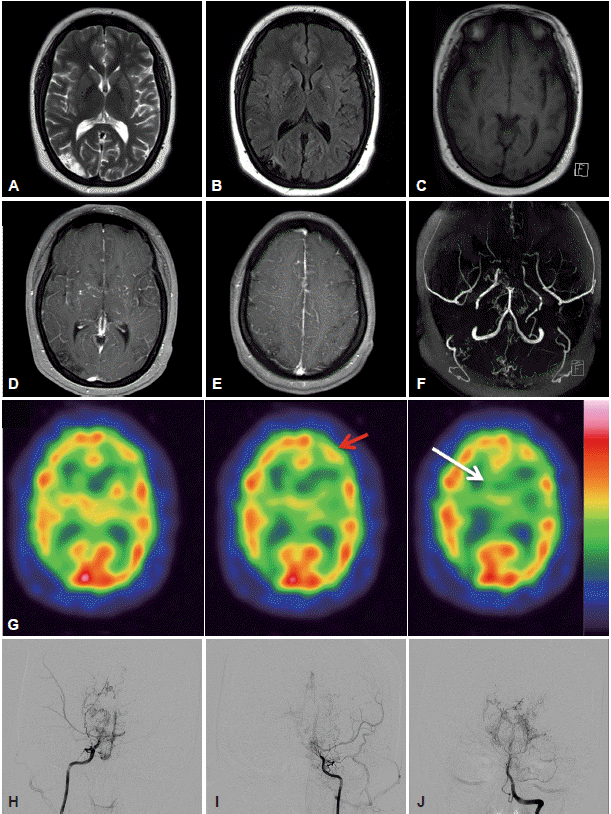Articles
- Page Path
- HOME > J Mov Disord > Volume 9(1); 2016 > Article
-
Letter to the editor
Acute Chorea Onset after Hot Food Consumption in a Patient with Moyamoya Disease - Hye Young Jung, Jee Eun Lee, Ilung Kang, Yong Bang Kim, Hyung-Eun Park, Joong-Seok Kim
-
Journal of Movement Disorders 2016;9(1):50-52.
DOI: https://doi.org/10.14802/jmd.15048
Published online: January 25, 2016
Department of Neurology, College of Medicine, The Catholic University of Korea, Seoul, Korea
- Corresponding author: Joong-Seok Kim, MD, PhD, Department of Neurology, Seoul St. Mary’s Hospital, College of Medicine, The Catholic University of Korea, 222 Banpo-daero, Seocho-gu, Seoul 06591, Korea / Tel: +82-2-2258-6078 / Fax: +82-2-599-9686 / E-mail: neuronet@catholic.ac.kr
• Received: October 20, 2015 • Revised: November 9, 2015 • Accepted: December 1, 2015
Copyright © 2016 The Korean Movement Disorder Society
This is an Open Access article distributed under the terms of the Creative Commons Attribution Non-Commercial License (http://creativecommons.org/licenses/by-nc/3.0) which permits unrestricted non-commercial use, distribution, and reproduction in any medium, provided the original work is properly cited.
Supplementary Materials
Supplementary Video Legends
Figure 1.A, B, and C: Magnetic resonance imaging (MRI) of the brain showed a low signal intensity on the right parieto-occipital area and multiple flow-voids in both basal ganglia on T2-, T1-, and fluid attenuation inversion recovery-weighted images. D and E: Contrast-enhanced MRI showed diffuse leptomeningeal enhancement along the cortical sulci and strong enhancement of perforating arteries in the basal ganglia and deep white matter (“ivy sign”). F: Magnetic resonance cerebral angiography revealed a severe stenosis of both internal carotid arteries at the supraclinoid portion with numerous collateral vessels. G: A 99mTc-hexamethylpropylene amieoxime brain single photon emission computed tomography showed decreased perfusions in the right temporo-occipital cortex and bilateral frontal areas (red arrow) and in both basal ganglia (white arrow). H, I, and J: Digital subtraction cerebral angiography confirmed the moyamoya disease (Suzuki grade IV).


- 1. Pandey P, Bell-Stephens T, Steinberg GK. Patients with moyamoya disease presenting with movement disorder. J Neurosurg Pediatr 2010;6:559–566.ArticlePubMed
- 2. Baik JS, Lee MS. Movement disorders associated with moyamoya disease: a report of 4 new cases and a review of literatures. Mov Disord 2010;25:1482–1486.ArticlePubMed
- 3. Fukui M, Kono S, Sueishi K, Ikezaki K. Moyamoya disease. Neuropathology 2000;20 Suppl:S61–S64.Article
- 4. Mikulis DJ, Krolczyk G, Desal H, Logan W, Deveber G, Dirks P, et al. Preoperative and postoperative mapping of cerebrovascular reactivity in moyamoya disease by using blood oxygen level-dependent magnetic resonance imaging. J Neurosurg 2005;103:347–355.ArticlePubMed
- 5. Han SH, Kim YG, Cha SH, Chung SY. Moyamoya disease presenting with singing induced chorea. J Neurol Neurosurg Psychiatry 2000;69:833–834.ArticlePubMedPMC
- 6. Spengos K, Tsivgoulis G, Toulas P, Vemmos K, Vassilopoulos D, Spengos M. Hyperventilation-enhanced chorea as a transient ischaemic phenomenon in a patient with moyamoya disease. Eur Neurol 2004;51:172–175.ArticlePubMed
REFERENCES
Figure & Data
References
Citations
Citations to this article as recorded by 

- Transient Hemichorea-hemiballism Induced by a Combination of Postprandial Hypotension and Severe Stenosis of the Innominate Artery Concomitant with Left Carotid Occlusion
Sho Okune, Mikito Hayakawa, Tenyu Hino, Takato Hiramine, Taisuke Akimoto, Masayuki Sato, Yoshiro Ito, Aiki Marushima, Tomoya Takada, Eiichi Ishikawa, Akira Tamaoka, Yuji Matsumaru
Internal Medicine.2024; 63(4): 577. CrossRef - Spicy foods triggering clinical symptoms in Moyamoya angiopathy
Souvik DUBEY, Ritwik GHOSH, Subhankar CHATTERJEE, Mahua J. DUBEY, Biman K. RAY, Shambaditya DAS, Apratim CHATTERJEE, Durjoy LAHIRI, Markus KRAEMER
Journal of Neurosurgical Sciences.2021;[Epub] CrossRef - Corticostriatal Hypermetabolism in Moyamoya Disease-Induced Hemichorea: Two Case Reports and a Literature Review
Wen-biao Xian, Xiang-song Zhang, Xin-chong Shi, Gan-hua Luo, Chang Yi, Zhong Pei
Frontiers in Neurology.2021;[Epub] CrossRef - Transient Ischemic Attack after Eating Spicy Foods in Children: Think of Moya Moya Disease
Thomas Mathew, DelonD Souza, SajiK John, GG Sharath Kumar
Neurology India.2021; 69(4): 1032. CrossRef - Asymmetric lenticulostriate arteries in patients with moyamoya disease presenting with movement disorder: three new cases
Jiali Xu, Sijie Li, Gary B. Rajah, Wenbo Zhao, Changhong Ren, Yuchuan Ding, Qian Zhang, Xunming Ji
Neurological Research.2020; 42(8): 665. CrossRef - Movement Disorders Following Cerebrovascular Lesions: Etiology, Treatment Options and Prognosis
Do-Young Kwon
Journal of Movement Disorders.2016; 9(2): 63. CrossRef
Comments on this article
 KMDS
KMDS
 E-submission
E-submission
 PubReader
PubReader ePub Link
ePub Link Cite
Cite

